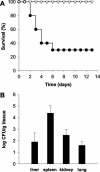Fusarium oxysporum as a multihost model for the genetic dissection of fungal virulence in plants and mammals
- PMID: 14977985
- PMCID: PMC356063
- DOI: 10.1128/IAI.72.3.1760-1766.2004
Fusarium oxysporum as a multihost model for the genetic dissection of fungal virulence in plants and mammals
Abstract
Fungal pathogens cause disease in plant and animal hosts. The extent to which infection mechanisms are conserved between both classes of hosts is unknown. We present a dual plant-animal infection system based on a single strain of Fusarium oxysporum, the causal agent of vascular wilt disease in plants and an emerging opportunistic human pathogen. Injection of microconidia of a well-characterized tomato pathogenic isolate (isolate 4287) into the lateral tail vein of immunodepressed mice resulted in disseminated infection of multiple organs and death of the animals. Knockout mutants in genes encoding a mitogen-activated protein kinase, a pH response transcription factor, or a class V chitin synthase previously shown to be implicated in virulence on tomato plants were tested in the mouse model. The results indicate that some of these virulence factors play functionally distinct roles during the infection of tomato plants and mice. Thus, a single F. oxysporum strain can be used to study fungal virulence mechanisms in plant and mammalian pathogenesis.
Figures





Similar articles
-
Galleria mellonella as model host for the trans-kingdom pathogen Fusarium oxysporum.Fungal Genet Biol. 2011 Dec;48(12):1124-9. doi: 10.1016/j.fgb.2011.08.004. Epub 2011 Aug 31. Fungal Genet Biol. 2011. PMID: 21907298
-
Distinct signalling pathways coordinately contribute to virulence of Fusarium oxysporum on mammalian hosts.Microbes Infect. 2006 Nov-Dec;8(14-15):2825-31. doi: 10.1016/j.micinf.2006.08.015. Epub 2006 Oct 19. Microbes Infect. 2006. PMID: 17095278
-
Class V chitin synthase determines pathogenesis in the vascular wilt fungus Fusarium oxysporum and mediates resistance to plant defence compounds.Mol Microbiol. 2003 Jan;47(1):257-66. doi: 10.1046/j.1365-2958.2003.03299.x. Mol Microbiol. 2003. PMID: 12492869
-
The Ubiquitous Wilt-Inducing Pathogen Fusarium oxysporum-A Review of Genes Studied with Mutant Analysis.Pathogens. 2024 Sep 24;13(10):823. doi: 10.3390/pathogens13100823. Pathogens. 2024. PMID: 39452695 Free PMC article. Review.
-
Current progress on pathogenicity-related transcription factors in Fusarium oxysporum.Mol Plant Pathol. 2021 Jul;22(7):882-895. doi: 10.1111/mpp.13068. Epub 2021 May 9. Mol Plant Pathol. 2021. PMID: 33969616 Free PMC article. Review.
Cited by
-
Fungal sex and pathogenesis.Clin Microbiol Rev. 2010 Jan;23(1):140-59. doi: 10.1128/CMR.00053-09. Clin Microbiol Rev. 2010. PMID: 20065328 Free PMC article. Review.
-
Conserved secreted effectors contribute to endophytic growth and multihost plant compatibility in a vascular wilt fungus.Plant Cell. 2022 Aug 25;34(9):3214-3232. doi: 10.1093/plcell/koac174. Plant Cell. 2022. PMID: 35689625 Free PMC article.
-
Characterization of Host-Specific Genes from Pine- and Grass-Associated Species of the Fusarium fujikuroi Species Complex.Pathogens. 2022 Jul 29;11(8):858. doi: 10.3390/pathogens11080858. Pathogens. 2022. PMID: 36014979 Free PMC article.
-
Identification of limiting factors for the optimum growth of fusarium oxysporum in liquid medium.Toxicol Int. 2011 Jul;18(2):111-6. doi: 10.4103/0971-6580.84262. Toxicol Int. 2011. PMID: 21976815 Free PMC article.
-
Transposons and accessory genes drive adaptation in a clonally evolving fungal pathogen.Nat Commun. 2025 Jul 30;16(1):6982. doi: 10.1038/s41467-025-62213-y. Nat Commun. 2025. PMID: 40739135 Free PMC article.
References
-
- Beckman, C. H. 1987. The nature of wilt diseases of plants. American Phytopathological Society, St. Paul, Minn.
-
- Boutati, E. I., and E. J. Anaissie. 1997. Fusarium, a significant emerging pathogen in patients with hematologic malignancy: ten years' experience at a cancer center and implications for management. Blood 90:999-1008. - PubMed
-
- Buer, J., and R. Balling. 2003. Mice, microbes and models of infection. Nat. Rev. Genet. 4:195-205. - PubMed
-
- Cabib, E., D. H. Roh, M. Schmidt, L. B. Crotti, and A. Varma. 2001. The yeast cell wall and septum as paradigms of cell growth and morphogenesis. J. Biol. Chem. 276:19679-19682. - PubMed
-
- Caracuel, Z., M. I. Roncero, E. A. Espeso, C. I. Gonzalez-Verdejo, F. I. Garcia-Maceira, and A. Di Pietro. 2003. The pH signalling transcription factor PacC controls virulence in the plant pathogen Fusarium oxysporum. Mol. Microbiol. 48:765-779. - PubMed
Publication types
MeSH terms
Substances
LinkOut - more resources
Full Text Sources
Medical

